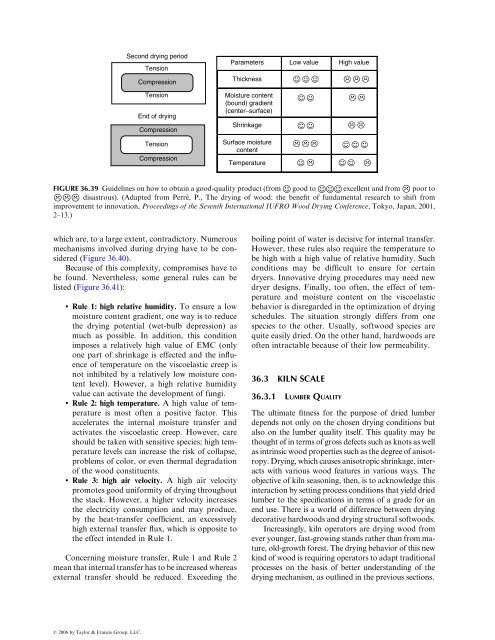36 Drying of Wood
36 Drying of Wood
36 Drying of Wood
- No tags were found...
Create successful ePaper yourself
Turn your PDF publications into a flip-book with our unique Google optimized e-Paper software.
Second drying periodTensionParametersLow valueHigh valueCompressionThicknessTensionEnd <strong>of</strong> dryingCompressionMoisture content(bound) gradient(center−surface)ShrinkageTensionCompressionSurface moisturecontentTemperatureFIGURE <strong>36</strong>.39 Guidelines on how to obtain a good-quality product (from good to excellent and from poor todisastrous). (Adapted from Perré, P., The drying <strong>of</strong> wood: the benefit <strong>of</strong> fundamental research to shift fromimprovement to innovation, Proceedings <strong>of</strong> the Seventh International IUFRO <strong>Wood</strong> <strong>Drying</strong> Conference, Tokyo, Japan, 2001,2–13.)which are, to a large extent, contradictory. Numerousmechanisms involved during drying have to be considered(Figure <strong>36</strong>.40).Because <strong>of</strong> this complexity, compromises have tobe found. Nevertheless, some general rules can belisted (Figure <strong>36</strong>.41):. Rule 1: high relative humidit To y. ensure a lowmoisture content gradient, one way is to reducethe drying potential (wet-bulb depression) asmuch as possible. In addition, this conditionimposes a relatively high value <strong>of</strong> EMC (onlyone part <strong>of</strong> shrinkage is effected and the influence<strong>of</strong> temperature on the viscoelastic creep isnot inhibited by a relatively low moisture contentlevel). However, a high relative humidityvalue can activate the development <strong>of</strong> fungi.. Rule 2: high tem perature. A high value <strong>of</strong> temperatureis most <strong>of</strong>ten a positive factor. Thisaccelerates the internal moisture transfer andactivates the viscoelastic creep. However, careshould be taken with sensitive species; high temperaturelevels can increase the risk <strong>of</strong> collapse,problems <strong>of</strong> color, or even thermal degradation<strong>of</strong> the wood constituents.. Rule 3: high air velocity. A high air velocitypromotes good uniformity <strong>of</strong> drying throughoutthe stack. However, a higher velocity increasesthe electricity consumption and may produce,by the heat-transfer coefficient, an excessivelyhigh external transfer flux, which is opposite tothe effect intended in Rule 1.Concerning moisture transfer, Rule 1 and Rule 2meanthatinternaltransferhastobeincreasedwhereasexternal transfer should be reduced. Exceeding theboiling point <strong>of</strong> water is decisive for internal transfer.However, these rules also require the temperature tobe high with a high value <strong>of</strong> relative humidity. Suchconditions may be difficult to ensure for certaindryers. Innovative drying procedures may need newdryer designs. Finally, too <strong>of</strong>ten, the effect <strong>of</strong> temperatureand moisture content on the viscoelasticbehavior is disregarded in the optimization <strong>of</strong> dryingschedules. The situation strongly differs from onespecies to the other. Usually, s<strong>of</strong>twood species arequite easily dried. On the other hand, hardwoods are<strong>of</strong>ten intractable because <strong>of</strong> their low permeability.<strong>36</strong>.3 KILN SCALE<strong>36</strong>.3.1 LUMBER QUALITYThe ultimate fitness for the purpose <strong>of</strong> dried lumberdepends not only on the chosen drying conditions butalso on the lumber quality itself. This quality may bethought<strong>of</strong>in terms <strong>of</strong> gross defects suchas knotsaswellasintrinsicwoodpropertiessuchasthedegree<strong>of</strong>anisotropy.<strong>Drying</strong>,whichcausesanisotropicshrinkage,interactswith various wood features in various ways. Theobjective <strong>of</strong> kiln seasoning, then, is to acknowledge thisinteraction by setting process conditions that yield driedlumber to the specifications in terms <strong>of</strong> a grade for anend use. There is a world <strong>of</strong> difference between dryingdecorative hardwoods and drying structural s<strong>of</strong>twoods.Increasingly, kiln operators are drying wood fromever younger, fast-growing stands rather than from mature,old-growth forest. The drying behavior <strong>of</strong> this newkind <strong>of</strong> wood is requiring operators to adapt traditionalprocesses on the basis <strong>of</strong> better understanding <strong>of</strong> thedrying mechanism, as outlined in the previous sections.ß 2006 by Taylor & Francis Group, LLC.
















